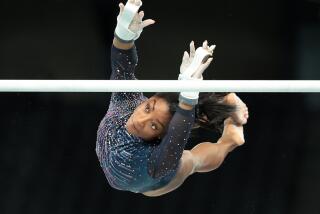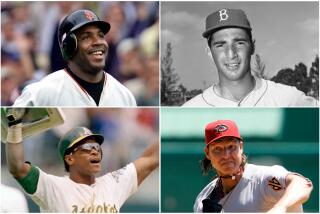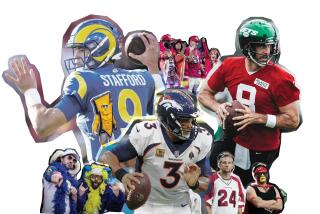Sports and the Art of Aging Gracefully
- Share via
When quarterbacks Neil O’Donnell and Troy Aikman go head-to-head in Sunday’s Super Bowl, they’ll be evenly matched, at least age-wise.
Both are 29. Statistically, they’re in their professional prime, since the average age of pro football players is 27, according to National Football League estimates.
It’d be quite another story if the duo were competitive gymnasts, where the average age for women participants is 12.
And if they were figure skaters, they’d be declared old men. Just ask Rudy Galindo, who won the U.S. men’s figure skating championship last week at age 26--the oldest competitor to claim the title in 70 years.
So why is a 14-year-old female gymnast already nail-biting about imminent oblivion and a 29-year-old quarterback not too worried that his body will betray him?
The wide variation in peak performance years of athletes is partly due, exercise experts say, to the specific, inherent demands of each sport.
“Distance runners can peak in their early 30s, but for swimmers, it can be all over by their early 20s,” says David Brennan, assistant professor of physical medicine and rehabilitation at Baylor College of Medicine and an exercise physiologist.
The earliest peaks tend to occur in sports such as gymnastics and swimming. In women’s gymnastics, for example, competitors with smaller, lighter frames excel because “flexibility is the issue,” Brennan says. But when puberty hits, changes in body composition--including increases in body fat--occur. And that plays havoc with performances.
“In women’s gymnastics, some are peaking now at 14 or 15,” says George H. McGlynn, professor and chair of the department of exercise and sports science at the University of San Francisco.
“Performance declines as body fat increases, breasts develop and the center of gravity changes,” he says.
Male gymnasts peak later, about 20, McGlynn says; again, that’s associated with the demands of the sport. “Good performance in men’s gymnastics demands good upper body strength,” he says. “Men mature a little later.”
That also helps explains why the average age for pro football, basketball and hockey players is about 27. “A football player is at his biggest and strongest in the mid-20s,” Brennan says.
“Basketball requires upper-body strength and that often does not develop until college,” adds McGlynn.
“The demands in hockey are similar and maybe tougher because of the increased personal contact,” Brennan says.
“Generally after age 30, things start to go south,” he says. Muscle mass declines. “It’s this loss of muscle mass that influences the loss of strength.” Consistent training can reverse it or at least slow it down.
*
But maintaining muscle mass is just part of the story.
“As you reach the early 30s, you begin to lose your quickness,” says Dr. Stephen Lombardo, orthopedic surgeon on staff at Kerlan-Jobe Orthopaedic Clinic in Inglewood and team physician for Los Angeles Lakers.
“Your flexibility and elasticity of your system changes, your recovery time changes. Of course there are exceptions. But generally, on a tissue level, the recuperative capacity of athletes diminishes with time as their performance ability diminishes. The injury rate generally goes up at about age 30.”
In some ways, baseball is one of the more forgiving sports. “It’s one of the few sports you don’t need a particular body type,” McGlynn says. Good endurance is not required of all players. “If you’re playing the outfield,” McGlynn asks, “how much running do you do?” But flexibility and good reaction time are required.
Tennis, on the other hand, can be one of the more grueling sports, exercise experts say. “Any minimal loss in strength and speed is noticeable in tennis,” Brennan says.
Within sports, there is variation in how long someone can perform, based on position. In football, for example, “a quarterback, who is relatively protected, is going to last a lot longer than a lineman, who’s getting a lot of wear and tear,” Brennan says.
“One of the hardest positions, skill-wise, is defensive back,” Lombardo says. “They are usually guarding the other athletes. They need speed plus strength. Sometimes they tackle players who may outweigh them by 100 pounds.”
*
And what about the exceptions, the Nolan Ryans of the world?
There’s some luck involved in longevity, says Michael Pollock, director of the Center for Exercise Science at the University of Florida, Gainesville. And, he points out, athletes who have suffered no major injuries tend to last longer.
“There’s no question that genetics [also] affects sports performance,” says Dr. Steven Van Camp, a San Diego cardiologist and president of the American College of Sports Medicine. It’s unlikely there is a single genetic determinant of athletic longevity, he says, but it’s plausible there are genetic factors involved that are not yet well-defined by researchers.
Whether athletes remain at their peak beyond expectations or drop out early is also linked to personal motivation.
“A lot simply give up because they are tired of training,” McGlynn says.
Money can’t hurt either.
“Financial incentives are often very powerful motives to extend their careers as long as possible,” Van Camp says.
(BEGIN TEXT OF INFOBOX / INFOGRAPHIC)
How Old Is Too Old?
Sport: Average Age or Age Range
Basketball: 27.56
Football: 27* (Range, 20-40)
Hockey: 27
Tennis: 22.8 (women) and 24.5 (men)
Gymnastics: 12* (women’s overall) and 14* (men’s overall)
Gymnastics: 15* (women’s elite) and 22* (men’s elite)
* Sources: National Football League, National Basketball Assn., National Hockey League, U.S. Tennis Assn., ATP Tour, USA Gymnastics. (Asterisks indicate estimates.)
More to Read
Go beyond the scoreboard
Get the latest on L.A.'s teams in the daily Sports Report newsletter.
You may occasionally receive promotional content from the Los Angeles Times.










